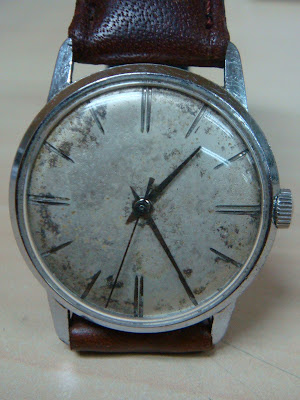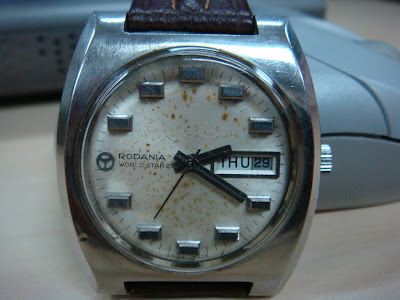



I like the dial. It is simple and classic look. Some facts about this watch : produced somewhere in the 50's. Using ZIM 2602 caliber, mechanical, manual winding,15 Rubies, sub seconds, chrome case, size 33 x 40 and wristband size is 18 mm. For sale RM 220.
Sold to Mr Shah.
Pobeda Movement - by Andrew BabaninThe history of watchmaking in Russia is not very long. Before the October revolution Russia had to assemble watches from ready parts, imported from Switzerland. It was more profitable to assemble watches in Russia because of tax barriers. For example you pay 4,5 roubles for ready watch or even 6 roubles for the same watch in gold case. And you pay about 0,75 rouble for enormous qty of spare parts. Most famous brands of that period were Henry Mozer, Pavel Bure, Victor Gabu, Freimuth, Kiseleff, Telefon. Some local workshops produced wallclocks and alarm clocks. Nobody even thought about watchmaking formation in tzar Russia.
After the 1917 revolution, the whole watch industry became a part of the ‘Trust of Precision Mechanics’. They were watch enterprises, work shops, warehouses of watch parts and half-finished products which belonged to famous manufacturers, mentioned before. The first time the Soviets assembled watches from the spare parts, left in Russia after the revolution - there were Longines, Zenit, Omega, HM etc.
But to 1926 all warehouses were out of spare parts. Only in 1927th there was a decision to start watch producing in Russia. First Soviet watch had been manufactured in 1930. Primarily Russia used foreign bimetallic balance wheels, bouchons, screws. Then the Soviets began producing their own jewels and balances. I won't say it was a perfect quality - but it was fully made in Russia! This movement (pocket one) came up to WW2.
To start production, the four types of watches were chosen: a man's pocket watch with 15 jewels for the enterprises of the Narkomat (Ministry) of Means of Communications, a man's wrist-watch with 7 jewels for the Red Army; a man's pocket watch with 7 jewels and a ladies' wrist-watch with 15 jewels to sell in a market. For the prototype there had been chosen a French "Lip" movement R43 (43 mm in diameter).
In December, 1941 the most part of equipment and personnel was displaced to Zlatoust in Chelyabinsk region. Until nowadays it produces some stopwatches and AChS-11(AChS (aviation clock) - a chronograph with a second timer and with the movement of a flight time meter. Run duration by one wind up of the spring is 120 hours. Operative temperature range –60oC to +50oC. Produced in different variations from 1933), the modernized 1st MWF pre-war production. Then in 1942 another factory was evacuated in Chistopol. It was incipience of "Vostok" factory. Most of this equipment had left after the war in Chistopol. During the World War Two evacuated the plant stopped producing watches and worked for military aims. After the WW2 there were enough machinery and (more important) many watch specialists to found Chistopol watch plant with "Vostok" trade mark.
According to the agreement (reparations) after the WW2 Russia had got from Germany some equipment, tools, etc. Glashutte factories had lost almost all machinery. It was quite new equipment, so the Russians were able to produce modern movements of that time, using high class of finishing. The 1st Moscow Watch Factory (now Poljot) started producing K-26 ("Pobeda") in 1946. The "Pobeda" movement is based on the well known for us "Lip" R26. It's a VERY reliable movement. Many of them work for 40-50 years! Recently there was a joke among Russian watchmakers: You shouldn't clean "Pobeda" not to spoil a structure of dirt.
The first time "Pobeda" had been manufactured only at the 1st Moscow Watch Factory (1947-1953). Then it started producing more modern watches and displaced "Pobeda" to other factories. There were "Vostok", the 2nd Moscow Watch Factory, ZIM (Zavod Imeni Maslenikova - a watch factory in Samara) and "Raketa". Every manufacture had some changes with the movement. Vostok added calendar and two cap jewels to escape wheel, besides it began producing movements with Incabloc protection. "Raketa" started later, I'd never met "Raketas" with a calendar, but they added to the original movement a central jewel. ZIM produced the cheapest variant of base movement.
It can be funny, but nowadays "Pobeda" is still under production. I do not have any info what plant makes it (Maybe ZIM). The Chinese look like finishing and original design (15 jewels, no central jewel, no shock absorbing device) won't make any pleasure.


























